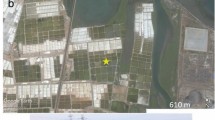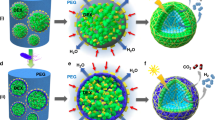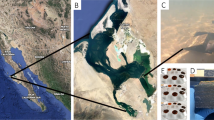Abstract
Hydrogen (H2) release from photosynthetic microbial mats has contributed to the chemical evolution of Earth and could potentially be a source of renewable H2 in the future. However, the taxonomy of H2-producing microorganisms (hydrogenogens) in these mats has not been previously determined. With combined biogeochemical and molecular studies of microbial mats collected from Elkhorn Slough, Monterey Bay, California, we characterized the mechanisms of H2 production and identified a dominant hydrogenogen. Net production of H2 was observed within the upper photosynthetic layer (0–2 mm) of the mats under dark and anoxic conditions. Pyrosequencing of rRNA gene libraries generated from this layer demonstrated the presence of 64 phyla, with Bacteriodetes, Cyanobacteria and Proteobacteria dominating the sequences. Sequencing of rRNA transcripts obtained from this layer demonstrated that Cyanobacteria dominated rRNA transcript pyrotag libraries. An OTU affiliated to Microcoleus spp. was the most abundant OTU in both rRNA gene and transcript libraries. Depriving mats of sunlight resulted in an order of magnitude decrease in subsequent nighttime H2 production, suggesting that newly fixed carbon is critical to H2 production. Suppression of nitrogen (N2)-fixation in the mats did not suppress H2 production, which indicates that co-metabolic production of H2 during N2-fixation is not an important contributor to H2 production. Concomitant production of organic acids is consistent with fermentation of recently produced photosynthate as the dominant mode of H2 production. Analysis of rRNA % transcript:% gene ratios and H2-evolving bidirectional [NiFe] hydrogenase % transcript:% gene ratios indicated that Microcoelus spp. are dominant hydrogenogens in the Elkhorn Slough mats.
Similar content being viewed by others
Log in or create a free account to read this content
Gain free access to this article, as well as selected content from this journal and more on nature.com
or
Accession codes
References
Altschul SF, Gish W, Miller W, Myers EW, Lipman DJ . (1990). Basic local alignment search tool. J Mol Biol 215: 403–410.
Ashelford KE, Weightman AJ, Fry JC . (2002). PRIMROSE: a computer program for generating and estimating the phylogenetic range of 16S rRNA oligonucleotide probes and primers in conjunction with the RDP-II database. Nucleic Acids Res 30: 3481–3489.
Barz M, Beimgraben C, Staller T, Germer F, Opitz F, Marquardt C et al. (2010). Distribution analysis of hydrogenases in surface waters of marine and freshwater environments. PLoS ONE 5: e13846.
Bebout BM, Fitzpatrick MW, Paerl HW . (1993). Identification of the sources of energy for nitrogen fixation and physiological characterization of nitrogen-fixing members of a marine microbial mat community. Appl Environ Microbiol 59: 1495–1503.
Bender J, Phillips P . (2004). Microbial mats for multiple applications in aquaculture and bioremediation. Bioresour Technol 94: 229–238.
Bolhuis H, Severin I, Confurius-Guns V, Wollenzien UI, Stal LJ . (2010). Horizontal transfer of the nitrogen fixation gene cluster in the cyanobacterium Microcoleus chthonoplastes. ISME J 4: 121–130.
Bolhuis H, Stal LJ . (2011). Analysis of bacterial and archaeal diversity in coastal microbial mats using massive parallel 16S rRNA gene tag sequencing. ISME J; e-pub ahead of print 5 May 2011; doi:10.1038/ismej.2011.52.
Bothe H, Schmitz O, Yates MG, Newton WE . (2010). Nitrogen fixation and hydrogen metabolism in cyanobacteria. Microbiol Mol Biol R 74: 529.
Boyd ES, Hamilton TL, Spear JR, Lavin M, Peters JW . (2010). [FeFe]-hydrogenase in yellowstone national park: evidence for dispersal limitation and phylogenetic niche conservatism. ISME J 4: 1485–1495.
Boyd ES, Spear JR, Peters JW . (2009). [FeFe] hydrogenase genetic diversity provides insight into molecular adaptation in a saline microbial mat community. Appl Environ Microbiol 75: 4620–4623.
Canfield DE, Des Marais DJ . (1991). Aerobic sulfate reduction in microbial mats. Science 251: 1471–1473.
Cohen Y, Jorgensen BB, Revsbech NP, Poplawski R . (1986). Adaptation to hydrogen sulfide of oxygenic and anoxygenic photosynthesis among cyanobacteria. Appl Environ Microbiol 51: 398–407.
De Wit R, van Boekel WHM, van Gemerden H . (1988). Growth of the cyanobacterium Microcoleus chthonoplastes on sulfide. FEMS Microbiol Ecol 53: 203–209.
Des Marais DJ . (2003). Biogeochemistry of hypersaline microbial mats illustrates the dynamics of modern microbial ecosystems and the early evolution of the biosphere. Biol Bull 204: 160–167.
DeSantis TZ, Hugenholtz P, Larsen N, Rojas M, Brodie EL, Keller K et al. (2006). Greengenes, a chimera-checked 16S rRNA gene database and workbench compatible with ARB. Appl Environ Microbiol 72: 5069–5072.
Edgar RC . (2004). MUSCLE: multiple sequence alignment with high accuracy and high throughput. Nucleic Acids Res 32: 1792–1797.
Engelbrektson A, Kunin V, Wrighton KC, Zvenigorodsky N, Chen F, Ochman H et al. (2010). Experimental factors affecting PCR-based estimates of microbial species richness and evenness. ISME J 4: 642–647.
Garcia-Pichel F, Prufert-Bebout L, Muyzer G . (1996). Phenotypic and phylogenetic analyses show Microcoleus chthonoplastes to be a cosmopolitan cyanobacterium. Appl Environ Microbiol 62: 3284–3291.
Garlick S, Oren A, Padan E . (1977). Occurence of facultative anoxygenic photosynthesis among filamentous and unicellular cyanobacteria. J Bacteriol 129: 623–629.
Hill TC, Walsh KA, Harris JA, Moffett BF . (2003). Using ecological diversity measures with bacterial communities. FEMS Microbiol Ecol 43: 1–11.
Hoehler TM, Bebout BM, Des Marais DJ . (2001). The role of microbial mats in the production of reduced gases on the early Earth. Nature 412: 324–327.
Huang Y, Niu B, Gao Y, Fu L, Li W . (2010). CD-HIT Suite: a web server for clustering and comparing biological sequences. Bioinformatics 26: 680–682.
Hughes JB, Hellmann JJ, Ricketts TH, Bohannan BJ . (2001). Counting the uncountable: statistical approaches to estimating microbial diversity. Appl Environ Microbiol 67: 4399–4406.
Jones SE, Lennon JT . (2010). Dormancy contributes to the maintenance of microbial diversity. Proc Natl Acad Sci USA 107: 5881–5886.
Jorgensen BB, Cohen Y, Revsbech NP . (1986). Transition from anoxygenic to oxygenic photosynthesis in a Microcoleus chthonoplastes cyanobacterial mat. Appl Environ Microbiol 51: 408–417.
Kunin V, Hugenholtz P . (2010). PyroTagger: A fast, accurate pipeline for analysis of rRNA amplicon pyrosequence data. Open J 1: e1.
Kunin V, Raes J, Harris J, Spear J, Walker J, Ivanova N et al. (2008). Millimeter-scale genetic gradients and community-level molecular convergence in a hypersaline microbial mat. Mol Syst Biol 4: e198.
Lee H, Vermaas WFJ, Rittmann BE . (2010). Biological hydrogen production: prospects and challenges. Trends Biotechnol 28: 262–271.
Ley RE, Harris JK, Wilcox J, Spear JR, Miller SR, Bebout BM et al. (2006). Unexpected diversity and complexity of the guerrero negro hypersaline microbial mat. Appl Environ Microbiol 72: 3685–3695.
Ludwig W, Strunk O, Westram R, Richter L, Meier H . (2004). ARB: a software environment for sequence data. Nucleic Acids Res 32: 1363–1371.
Markowitz VM, Korzeniewski F, Palaniappan K, Szeto E, Werner G, Padki A et al. (2006). The integrated microbial genomes (IMG) system. Nucleic Acids Res 34: D344–D348.
Moezelaar R, Bijvank SM, Stal LJ . (1996). Fermentation and sulfur reduction in the mat-building cyanobacterium Microcoleus chthonoplastes. Appl Environ Microbiol 62: 1752–1758.
Nisbet EG, Fowler CMR . (1999). Archaean metabolic evolution of microbial mats. Proc R Soc Lond B Biol Sci 266: 2375–2382.
Pruesse E, Quast C, Knittel K, Fuchs BM, Ludwig W, Peplies J et al. (2007). SILVA: a comprehensive online resource for quality checked and aligned ribosomal RNA sequence data compatible with ARB. Nucleic Acids Res 35: 7188–7196.
Rodriguez-Blanco A, Ghiglione JF, Catala P, Casamayor EO, Lebaron P . (2009). Spatial comparison of total vs active bacterial populations by coupling genetic fingerprinting and clone library analyses in the NW Mediterranean Sea. FEMS Microbiol Ecol 67: 30–42.
Skyring GW, Lynch RM, Smith GD . (1988). Acetylene reduction and hydrogen metabolism by a cyanobacterial/sulfate-reducing bacterial mat ecosystem. Geomicrobiol J 6: 25–31.
Skyring GW, Lynch RM, Smith GD . (1989). Quantitative relationship between carbon, hydrogen and sulfur metabolism in cyanobacterial mats. In Cohen Y, Rosenberg E (eds), Microbial mats: Physiological ecology of benthic microbial communities. American Society for Microbiology: Washington, DC, pp. 170–179.
Stal LJ, Moezelaar R . (1997). Fermentation in cyanobacteria. FEMS Microbiol Rev 21: 179–211.
Stewart WD, Fitzgerald GP, Burris RH . (1967). In situ studies on N2-fixation using the acetylene reduction technique. Proc Natl Acad Sci USA 58: 2071–2078.
Tamagnini P, Leitao E, Oliveira P, Ferreira D, Pinto F, Harris DJ et al. (2007). Cyanobacterial hydrogenases: diversity, regulation and applications. FEMS Microbiol Rev 31: 692–720.
Vignais PM, Billoud B . (2007). Occurrence, classification, and biological function of hydrogenases: an overview. Chem Rev 107: 4206–4272.
Widdel F . (1987). New types of acetate-oxidizing, sulfate-reducing Desulfobacter species, D hydrogenophilus sp. nov, D latus sp. Nov and D curvatus sp. nov. Arch Microbiol 148: 286–291.
Acknowledgements
We thank Michael Kubo, Adrienne Frisbee, Angela Detweiler and Erich Fleming for technical support. We thank Tijana Glavina del Rio, Susannah Tringe and Stephanie Malfatti of the Joint Genome Institute for assistance obtaining and analyzing amplicon pyrosequencing. Funding was provided by the U.S. Department of Energy (DOE) Genomic Sciences Program under contract SCW1039. Work at LLNL was performed under the auspices of the U.S. Department of Energy at Lawrence Livermore National Laboratory under Contract DE-AC52-07NA27344. Work at LBNL was performed under the auspices of the U.S. Department of Energy at Lawrence Berkeley National Laboratory under Contract DE-AC02-05CH11231. DW was supported by the German Research Foundation (Deutsche Forschungsgemeinschaft).
Author information
Authors and Affiliations
Corresponding author
Additional information
Supplementary Information accompanies the paper on The ISME Journal website
Supplementary information
Rights and permissions
About this article
Cite this article
Burow, L., Woebken, D., Bebout, B. et al. Hydrogen production in photosynthetic microbial mats in the Elkhorn Slough estuary, Monterey Bay. ISME J 6, 863–874 (2012). https://doi.org/10.1038/ismej.2011.142
Received:
Revised:
Accepted:
Published:
Issue date:
DOI: https://doi.org/10.1038/ismej.2011.142
Keywords
This article is cited by
-
Upregulation of Hox-hydrogenase gene expression by nutrient adjustment in the filamentous non-heterocystous cyanobacterium Arthrospira sp. PCC 8005
Journal of Applied Phycology (2020)
-
Cyanobacterial diversity in the algal–bacterial consortia from Subarctic regions: new insights from the rock baths at White Sea Coast
Hydrobiologia (2019)
-
Metagenomic analysis of intertidal hypersaline microbial mats from Elkhorn Slough, California, grown with and without molybdate
Standards in Genomic Sciences (2017)
-
Permanent draft genome of strain ESFC-1: ecological genomics of a newly discovered lineage of filamentous diazotrophic cyanobacteria
Standards in Genomic Sciences (2016)
-
Cyanobacterial reuse of extracellular organic carbon in microbial mats
The ISME Journal (2016)



